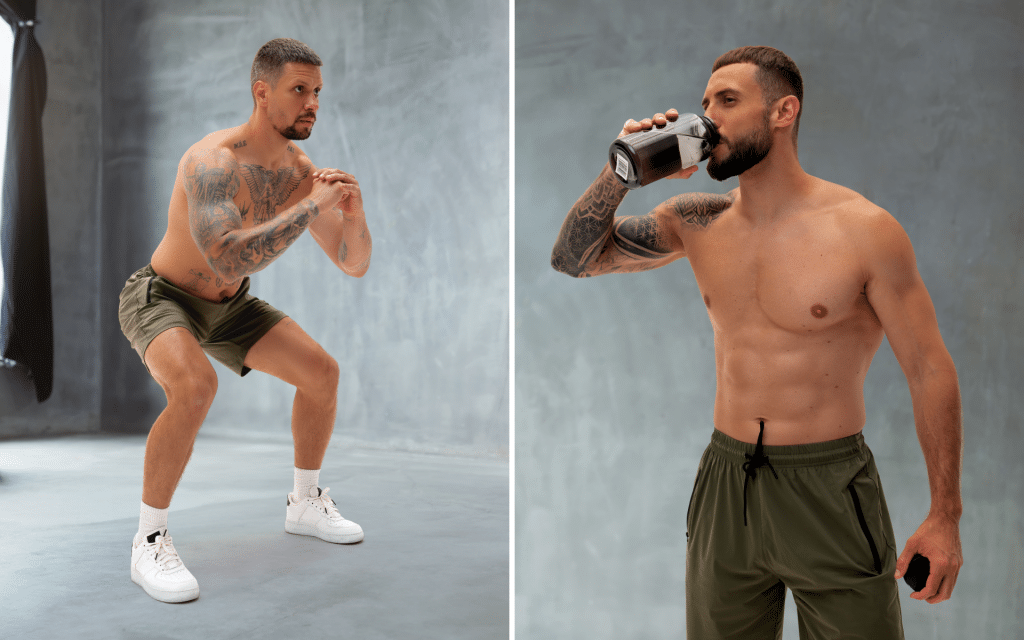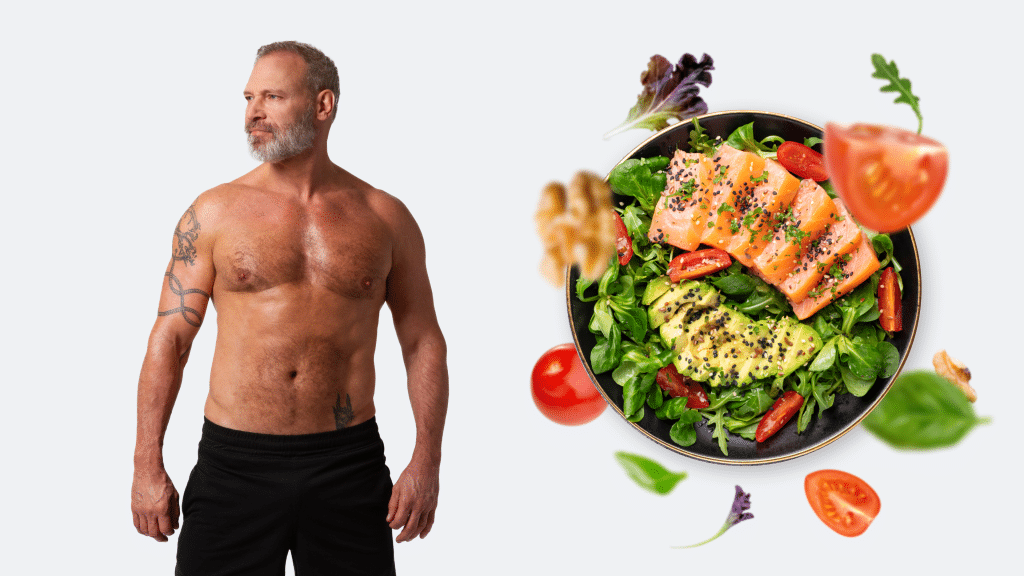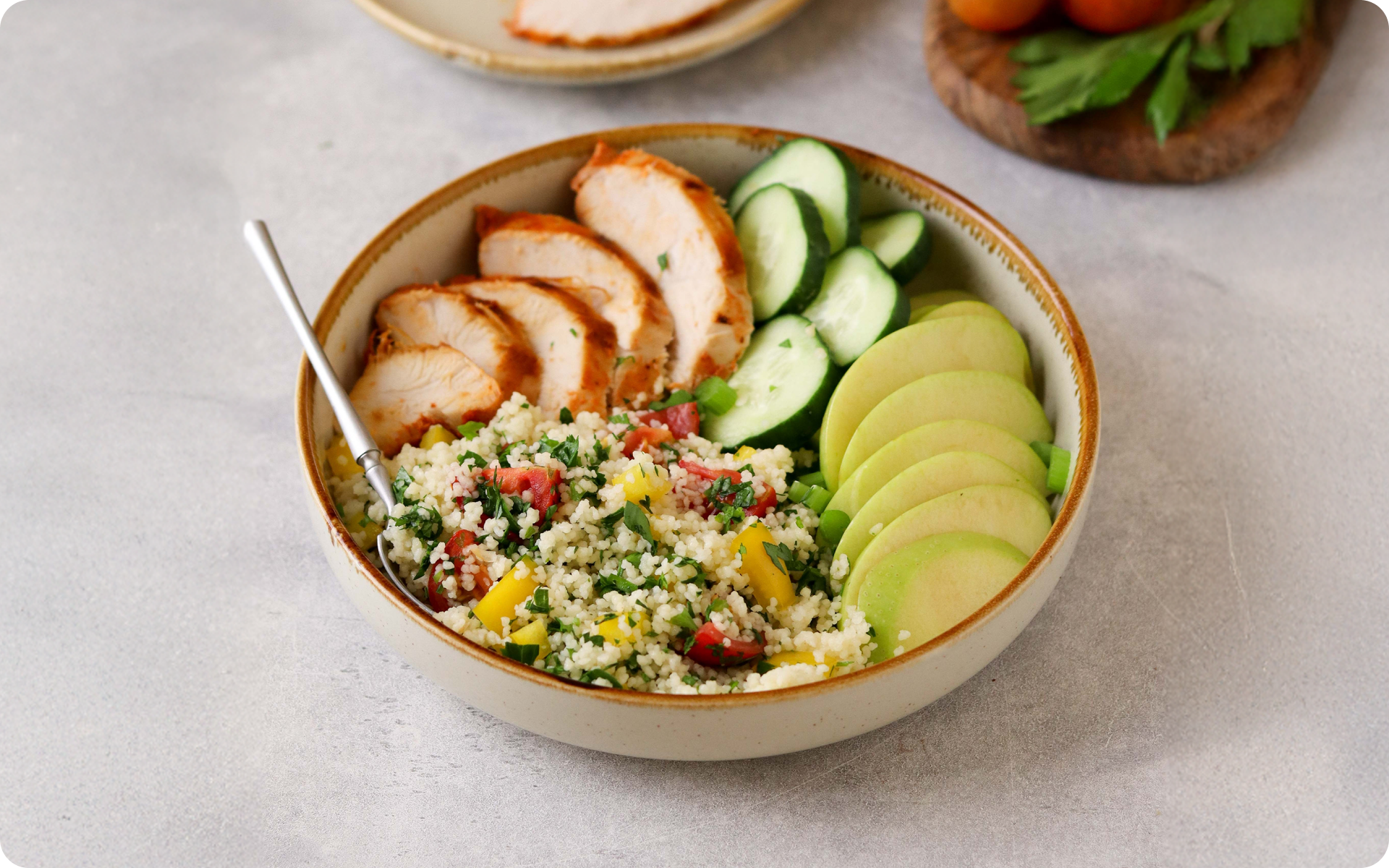In fitness and nutrition, a cut cycle refers to a phase that is focused on reducing body fat while maintaining lean muscle mass (1). It’s a careful balancing act that requires thought-out nutrition, a proper workout strategy, and a lot of consistency.
Cutting isn’t just about eating less; it’s about eating smarter. This process prioritizes nutrient-dense foods and strategic planning to create a calorie deficit while preserving the muscle you’ve built. For beginners especially, meal prep can be your best ally in making this process easier, more efficient, and even enjoyable.
In this guide, we’ll walk through practical, science-backed meal prep techniques that are tailored to help you thrive during your cut phase. Expect tips to streamline your planning, easy-to-customize meal ideas, and strategies to fuel your workouts while staying on track with your goals.
Can Meal Prepping Make a Cut Easier?
Yes, meal prepping can absolutely make a cut easier. It simplifies your nutrition strategy, helps you stay consistent with your goals, and takes the stress out of daily decision-making during a cutting phase.
- Ensures Calorie and Portion Control
One of the keys to cutting is maintaining a calorie deficit while keeping your protein intake high to help preserve muscle mass (2). Meal prepping allows you to portion out your meals accurately (3), which will ensure you hit the right calorie and macronutrient targets without guesswork.
- Saves Time and Reduces Stress
Planning your meals in advance means less time spent cooking during the week and fewer moments scrambling to put together something healthy on the fly. When you prep meals ahead of time, you’re more likely to stick to your plan, particularly on busy days.
- Minimizes Impulse Eating
When hunger strikes but you’re not prepared, it’s easy to reach for something quick and often unhealthy. With meal prepping, you always have balanced, nutrient-dense options ready, which reduces the temptation to stray from your cutting goals.
- Improves Nutrient Quality
Prepping meals gives you control over what goes into your food (3). You can prioritize nutrient-dense, minimally processed ingredients that fuel your body and avoid excess sugars, salts, or fats that may undermine your progress.
When it comes to weight loss, progress is made by inches, not miles, so it’s much harder to track and a lot easier to give up. The BetterMe: Health Coaching app is your personal trainer, nutritionist, and support system all in one. Start using our app to stay on track and hold yourself accountable!
- Supports Consistent Protein Intake
Maintaining muscle during a cut requires eating enough protein throughout the day (4). Prepping protein-rich meals or snacks will ensure you meet these needs without hassle. Think grilled chicken, hard-boiled eggs, or pre-portioned Greek yogurt.
- Encourages Better Recovery and Performance
With pre-planned meals, you’ll get the nutrients your body needs to recover from workouts and power through your training regimen. This will keep your energy levels up and help you maintain muscle while shedding fat.
- Builds Sustainable Habits
Beyond the cut, meal prepping can teach you the value of planning and consistency. It’s a habit you can carry forward to help you maintain a balanced diet and a healthier relationship with food long-term.
Read more: 7 Benefits of Not Snacking and What Happens to Your Body When You Quit
How to Start Meal Prepping on a Cut
Meal prepping during a cutting phase doesn’t need to feel overwhelming, even if you’re new to it. With the right approach, you can set yourself up for success and take some of the guesswork out of eating smarter.
Follow these steps to build a meal prep routine that works for your cutting phase and evolves as you do:
1. Set Clear Goals
Before you touch a cutting board, define your goals. Are you aiming for a specific calorie deficit? Do you know how much protein, fats, and carbs (macros) you need to maintain muscle while burning fat? Take time to calculate your daily needs using an online calculator or consult a dietitian to get specialized guidance. Clear goals will give your plan purpose.
2. Plan Your Meals
Grab a notebook or use a meal planning app and decide what you want to eat for the week. Focus on meals that are high in protein, rich in fiber, balanced, and packed with nutrients. For example, a grilled chicken salad with quinoa and roasted vegetables covers all bases. Aim for a mix of variety and simplicity to avoid boredom while keeping your prep time manageable.
3. Create a Grocery List
Once you’ve planned your meals, write down a detailed grocery list. Group items by category (proteins, vegetables, pantry staples) to streamline your shopping trip. Having a list will ensure you don’t forget essentials and it will help you avoid buying foods that aren’t aligned with your goals. It can also help minimize food waste and keep your grocery bills within your budget.
4. Choose a Prep Day
Pick a day and time each week to dedicate to meal prepping. Sundays are a popular choice, but any day that fits your schedule will work. Block off a couple of hours and treat it as non-negotiable. During this time, you’ll cook, portion, and store your meals for the days ahead.
5. Invest in the Right Tools
Good kitchen tools make meal prepping easier. Invest in airtight containers to keep your food fresh, measuring cups to portion accurately, and a high-quality knife to speed up chopping. A digital food scale is particularly useful when weighing ingredients for precise calorie and macro control. Depending on your budget, food processors and choppers can make certain tasks much quicker.
6. Batch Cook Your Staples
Start by prepping large quantities of versatile staples. Examples include roasted chicken breasts, brown rice, and steamed broccoli. These can be mixed and matched throughout the week to create balanced meals. You may also cook a protein-packed breakfast casserole or bake a batch of protein muffins for grab-and-go mornings.
7. Portion Your Meals
Portioning is where meal prep truly shines. Use containers to divide your meals into single servings. If one meal calls for 4 ounces of grilled chicken and 1 cup of roasted sweet potatoes, measure and pack accordingly. Label containers with meal names or days of the week for added convenience (5).
8. Optimize for Freshness
Store your prepped meals with care to keep them fresh. Refrigerate items you’ll eat within 3-4 days and freeze anything beyond that. Ingredients such as sauces can be kept separate to maintain texture and flavor. For example, store your stir-fry sauce in a small container and mix it with the freshly reheated vegetables and protein.
9. Schedule Time for Adjustments
Life happens and flexibility is key. You should leave room for tweaks in your plan. For example, if you’re craving variety midweek, swap one prepped dinner for a quick, healthy recipe. Having some structure with the flexibility to adjust will make meal prep feel less restrictive.
10. Track and Adjust
After a week or two, evaluate how things are going. Are you hitting your calorie and macro goals? Are the meals keeping you satisfied? Adjust the portions, ingredients, or seasoning based on your progress and preferences. Remember, the goal is to stay consistent, not perfect.
What Is an Easy Cutting Meal Prep Routine?
When starting a cutting meal prep routine, simplicity and consistency are essential. Here’s a good beginner’s routine you can follow to maintain muscle while burning fat:
Step 1: Define Your Weekly Goals
For this example, you should aim for 1,800 calories daily with 30% protein, 45% carbohydrates, and 25% fat. These macros should support fat loss while preserving muscle along with exercise. Adjustments can be made based on your personal needs and preferences.
Step 2: Plan the Menu
Keep things straightforward, with meals built around lean proteins, whole grains, and colorful vegetables. Here’s a breakdown of some potential weekly meals:
- Breakfast: Overnight oats with Greek yogurt and berries (high protein, fiber-rich).
- Lunch: Grilled chicken, brown rice, and steamed broccoli.
- Dinner: Turkey and bean chili with mixed greens.
- Snacks: Hard-boiled eggs, sliced vegetables with hummus, and a small portion of almonds.
- Treat: A square of dark chocolate or some low-fat cottage cheese with cinnamon.
Step 3: Prep Day (Sunday Example)
Here’s how to tackle prep in about 2-3 hours:
1. Cook Proteins:
- Grill 6 chicken breasts seasoned with garlic, paprika, and salt.
- Brown 1 pound of lean ground turkey for the chili.
- Hard-boil 8 eggs for snacks.
2. Cook Grains and Legumes:
- Make 4 cups of brown rice in a rice cooker or on the stovetop.
- Open and rinse 2 cans of black beans for the chili.
3. Prepare Vegetables:
- Roast a tray of broccoli, zucchini, and carrots with olive oil and Italian herbs.
- Chop celery, cucumbers, and peppers for raw snack vegetables.
4. Assemble Dishes and Store:
- Mix and portion overnight oats into 5 jars with Greek yogurt, oats, almond milk, and mixed berries.
- Divide chicken, rice, and broccoli into 5 containers for lunch.
- Prepare the turkey chili (enough for 4 servings) on the stovetop and portion it into containers.
Step 4: Weekly Routine
Here’s what a typical day may look like with this prep routine:
- Morning: Grab a jar of overnight oats for breakfast.
- Mid-Morning Snack: Snack on a hard-boiled egg and some raw vegetables.
- Lunch: Heat up the chicken, rice, and broccoli for a balanced, satisfying meal.
- Afternoon Snack: Pair cucumber slices with a portion of hummus, or enjoy a handful of almonds.
- Evening: Warm up a bowl of turkey chili and serve it alongside crisp mixed greens. A small square of dark chocolate or a dollop of cottage cheese makes for a guilt-free dessert.
Step 5: Adjust as Needed
Midway through the week, you can re-prep fresh vegetables or make a new snack option to keep things exciting. For example, you could bake protein muffins or marinate tofu for variety.
Step 6: Stay Flexible
Adapting the routine to your cravings, schedule, or leftovers will ensure meal prepping stays sustainable. Whether you swap chicken for fish or substitute quinoa for rice, the structure remains intact, supporting your goals with minimal effort.
What Is the Best Meal for Cutting?
The best meal for cutting is one that’s high in protein, rich in fiber, balanced with complex carbs and healthy fats, and strategically designed to create a calorie deficit while providing sustained energy. It should preserve lean muscle mass, promote fat loss, and most importantly, keep you satisfied.
Here’s what a well-rounded cutting meal might look like:
Grilled Chicken Breast (4-5 oz)
Chicken breast is a lean protein packed with essential amino acids that help maintain muscle (6) mass during a calorie deficit. It’s low in fat, which makes it an excellent staple for cutting.
Steamed Broccoli and Roasted Sweet Potatoes (1 cup of each)
Broccoli supplies fiber, vitamins, and antioxidants without adding many calories (7). Sweet potatoes provide slow-digesting carbohydrates for energy (8), in addition to a hint of natural sweetness to curb sugar cravings. Together, they create a nutrient-rich, colorful plate.
Avocado Slices (¼ avocado)
Avocado contributes heart-healthy fats that support hormonal balance and keep you feeling full (9). Fats are key during a cut as they add flavor and satisfaction to your meals. Avocado is also an excellent source of fiber, folate, and other nutrients.
Simple Seasoning and Olive Oil Drizzle
Sprinkle your chicken with spices such as paprika, garlic powder, or black pepper for flavor without added calories. Use a teaspoon of olive oil when roasting your vegetables for a dash of healthy fat and crispiness.
This combination strikes the perfect balance for cutting:
- Protein supports muscle repair and growth, helping to keep your lean mass intact (4).
- Complex Carbs fuel your workouts and stabilize your energy levels (10).
- Fiber helps with digestion and keeps you full, which helps you manage hunger (11).
- Healthy Fats slow digestion, keeping you satiated longer (12).
If chicken isn’t your favorite, swap it for lean turkey, white fish such as cod, or plant-based proteins such as tofu or chickpeas. Instead of sweet potatoes, try quinoa, farro, or brown rice for your carb source. Vegetables can be rotated depending on the season or your preference – think asparagus, spinach, Brussels sprouts, and many others.
Portion sizes matter during a cut. Use a food scale to weigh your proteins and carbs to ensure you meet your caloric and macronutrient targets. Adjust based on your personal goals and how active you are on any given day.
While there isn’t a single “best” meal for everyone, the model above is a great starting point. It’s versatile, simple to prepare, and packed with the nutrients you need for your cutting phase. The key is to find combinations you enjoy so meal prep becomes a sustainable part of your routine.
What Not to Eat when You Have a Cut
When you’re in a cutting phase, the goal is to preserve muscle, lose fat, and sustain energy levels with a calorie deficit. Certain foods or ingredients can hinder your progress as they contribute excess calories, lack essential nutrients, or lead to cravings and energy crashes. The foods mentioned above don’t necessarily need to be off-limits forever, but during a cut, they can make hitting your goals more difficult.
Here are the main culprits to avoid:
1. Sugary Drinks
Beverages such as soda, flavored sweet coffees, energy drinks, and even some fruit juices are loaded with added sugars and empty calories (13). These drinks can quickly push you over your calorie limit without providing any satiety or nutritional benefit.
Alternatives:
Stick to water, herbal tea, or black coffee for hydration. If you crave something flavored, try sparkling water with a splash of lemon or a dash of calorie-free flavor drops.
2. Highly-Processed Snacks
Chips, crackers, cookies, and other prepackaged snacks are often high in refined carbs, unhealthy fats, and sodium.
These snacks are low in protein and fiber, which means they don’t keep you full. They can also derail your cutting goals by adding unnecessary calories and contributing to cravings for more processed foods (14).
Alternatives:
Prepare nutrient-dense snacks in advance. Think hard-boiled eggs, Greek yogurt with berries, or a handful of raw nuts and seeds. These provide protein and healthy fats to keep you satisfied.
3. Fried Foods
Whether it’s fried chicken, French fries, or onion rings, fried foods are calorie-dense and nutrient-poor. They pack a lot of calories into small portions, which makes it difficult to stay in a deficit. They are often loaded with unhealthy fats. These fats may be harmful to your heart health and may contribute to inflammation (15).
Alternatives:
Choose baked or air-fried versions of your favorites. For example, opt for air-fried sweet potato wedges or oven-baked chicken tenders coated with almond flour.
4. Sugary or Refined Desserts
Cakes, pastries, candy, and ice cream may be tempting, but they’re often high in sugar and fat while offering minimal nutrient value. These sweets lead to quick energy bursts followed by crashes, leaving you hungry again in no time. They can also make it difficult to stop at one serving (16).
Alternatives:
Satisfy your sweet tooth with healthier options such as protein balls made with oats and nut butter, a square of dark chocolate, or fresh fruit with a dollop of whipped Greek yogurt.
Reasons why BetterMe is a safe bet: a wide range of calorie-blasting workouts, finger-licking recipes, 24/7 support, challenges that’ll keep you on your best game, and that just scratches the surface! Start using our app and watch the magic happen.
5. White Bread, Pasta, and Rice
Refined carbs such as white bread, pasta, and rice are stripped of fiber, which makes them less filling and prone to causing blood sugar spikes if they’re not balanced by other ingredients (10). They can make portion control tricky and may not keep you satiated for long.
Alternatives:
Opt for whole-grain or unrefined versions such as quinoa, brown rice, or whole-grain bread. These offer more fiber and nutrients, which keeps you fuller for longer. Pair your grains with lean protein, fiber-rich vegetables, and healthy fats for a balanced, satisfying meal.
6. Alcohol
Alcoholic beverages are calorie-dense and can also impair your metabolism and decision-making, potentially leading to overeating or choosing less nutritious foods.
Alcohol provides empty calories and can disrupt your body’s ability to burn fat efficiently and result in weight gain (17). It may also interfere with sleep (18), which is essential for muscle recovery and fat loss (19, 20).
Alternatives:
If you choose to drink, limit yourself to a small amount, such as light beer or a single glass of dry wine. For a non-alcoholic option, opt for sparkling water with a splash of lime.
7. Cheese and Heavy Cream-Based Dishes
While dairy can be part of a healthy diet, dishes that are loaded with cheese or creamy sauces are often calorie-dense and high in saturated fats.
Small portions of cheese-based dishes can add up quickly in calories, crowding out the nutrient-rich foods your body needs during a cut.
Alternatives:
Use reduced-fat dairy products or nutritional yeast as a substitute for a cheesy flavor. Add Greek yogurt to sauces for a creamy texture without the extra fat and calories.
Read more: How to Eat More Calories: A Healthily Approach
Should I Work Out While Cutting?
Yes, working out is highly recommended during a cutting phase. Combining exercise with a calorie deficit supports fat loss, helps preserve lean muscle mass, improves metabolism, and boosts overall health.
Why Exercise is Essential During a Cut
1. Preserves Lean Muscle Mass
When you’re in a calorie deficit, your body may break down muscle for energy if it’s not stimulated through exercise. Resistance training signals your body to maintain lean muscle, which is the key to looking toned as you lose fat (21).
2. Boosts Fat Loss Efficiency
Exercise increases your calorie burn, which helps you create a larger energy deficit. This means you can lose fat more efficiently without having to drastically reduce your food intake (22).
3. Supports Metabolism
Muscle tissue is metabolically active, which means the more muscle you have, the more calories you burn when at rest (23). By combining workouts with cutting, you can keep your metabolism functioning optimally.
4. Enhances Body Composition:
Exercise helps you simultaneously reduce body fat and maintain or reveal muscle definition (24), which leads to a leaner and healthier appearance.
Types of Workouts to Include
- Resistance Training (Strength Training):
Lifting weights or performing bodyweight exercises such as push-ups or squats is essential for maintaining and building muscle (25). Aim to include resistance training at least 3-4 times a week. Focus on compound movements such as deadlifts, bench presses, and pull-ups as they work multiple muscle groups and give you the most return on your effort. Isolation exercises are also effective for targeting specific muscles, but they shouldn’t be the main focus of your workouts.
- Cardiovascular (Aerobic) Exercise:
Cardio is great for improving heart health and burning calories (26). Incorporate activities such as running, cycling, swimming, or dancing into your routine at least 3-4 times a week. Aim to maintain a moderate intensity where you can still hold a conversation but feel slightly out of breath. You can also try high-intensity interval training (HIIT) to mix things up and challenge your body in a different way.
- Flexibility and Mobility Training:
Stretching and mobility exercises are often overlooked, but they play an important role in preventing injuries and maintaining range of motion (27). Incorporate dynamic stretching before workouts, such as leg swings or arm circles, to warm up your muscles (28). After your workout, take some time to stretch all major muscle groups for at least 10-15 minutes (29).
Yoga and Pilates are also great options for improving flexibility and mobility and they also provide a mind-body connection. These practices can help reduce stress, improve balance, and promote relaxation (30).
Balancing Exercise with Recovery
1. Prioritize Rest Days:
Your muscles need time to recover and grow stronger, particularly when you’re in a calorie deficit. Include 1-2 rest days per week, focusing on light activities such as walking or stretching.
2. Monitor Workout Intensity:
While challenging yourself is important, overtraining can lead to fatigue and muscle loss. Pay attention to how your body feels and avoid pushing too hard.
3. Match Recovery to Your Workouts:
Recovery doesn’t just mean rest, it includes proper nutrition. Make sure you’re consuming adequate protein and carbohydrates to support muscle repair and replenish your energy stores.
Yes, rice is safe to meal prep as long as it’s handled and stored properly. Cool cooked rice quickly after preparation and store it in airtight containers in your fridge for up to 4 days. For longer storage, freeze it. Improper storage can promote bacterial growth, so reheating rice thoroughly to steaming hot is essential for food safety (31). Yes, you can meal prep scrambled eggs, but they’re best consumed within 3-4 days when stored in the fridge. Prepare them slightly undercooked initially, as reheating can dry them out. Store in airtight containers and pair with other meal components such as sautéed vegetables or whole-grain toast for a balanced option. Yes, you can meal prep chicken for a week, but for optimal freshness and safety, refrigerate cooked chicken for up to 4 days. For the remaining days, freeze the portions and thaw them as required. Ensure the chicken is cooked to an internal temperature of 165°F and stored in airtight containers (32). The main cons of meal prep include the upfront time investment for planning and preparation, the potential for food monotony if your meals lack variety, and the need for proper storage to prevent spoilage. However, these drawbacks can be managed with time management, innovative recipes, and safe food handling practices.Frequently Asked Questions
Is rice safe to meal prep?
Can you meal prep scrambled eggs?
Can you meal prep chicken for a week?
What are the cons of meal prep?
The Bottom Line
Cutting meal prep is a powerful tool that simplifies nutrition, saves time, and supports your fat loss and muscle maintenance goals. By planning balanced, nutrient-rich meals, you can remain consistent, reduce decision fatigue, and avoid common diet pitfalls such as overeating or impulse snacking. Whether you’re a beginner or you’re looking to refine your routine, the steps and tips that are shared here can help you take control of your cutting phase with confidence.
DISCLAIMER:
This article is intended for general informational purposes only and does not serve to address individual circumstances. It is not a substitute for professional advice or help and should not be relied on for making any kind of decision-making. Any action taken as a direct or indirect result of the information in this article is entirely at your own risk and is your sole responsibility.
BetterMe, its content staff, and its medical advisors accept no responsibility for inaccuracies, errors, misstatements, inconsistencies, or omissions and specifically disclaim any liability, loss or risk, personal, professional or otherwise, which may be incurred as a consequence, directly or indirectly, of the use and/or application of any content.
You should always seek the advice of your physician or other qualified health provider with any questions you may have regarding a medical condition or your specific situation. Never disregard professional medical advice or delay seeking it because of BetterMe content. If you suspect or think you may have a medical emergency, call your doctor.
SOURCES:
- “Bulking and cutting” among a national sample of Canadian adolescents and young adults (2022, ncbi.nlm.nih.gov)
- Body Recomposition: Can Trained Individuals Build Muscle and Lose Fat at the Same Time? (2020, journals.lww.com)
- Meal planning is associated with food variety, diet quality and body weight status in a large sample of French adults (2017, biomedcentral.com)
- Dietary Protein and Muscle Mass: Translating Science to Application and Health Benefit (2019, ncbi.nlm.nih.gov)
- Food Portions: Choosing Just Enough for You (2021, niddk.nih.gov)
- Role of poultry meat in a balanced diet aimed at maintaining health and wellbeing: an Italian consensus document (2015, ncbi.nlm.nih.gov)
- Broccoli: A Multi-Faceted Vegetable for Health: An In-Depth Review of Its Nutritional Attributes, Antimicrobial Abilities, and Anti-inflammatory Properties (2023, ncbi.nlm.nih.gov)
- Sweet Potato Is Not Simply an Abundant Food Crop: A Comprehensive Review of Its Phytochemical Constituents, Biological Activities, and the Effects of Processing (2022, ncbi.nlm.nih.gov)
- Avocado: Characteristics, health benefits and uses (2016, researchgate.net)
- Carbohydrates and Blood Sugar – The Nutrition Source (n.d., nutritionsource.hsph.harvard.edu)
- The Health Benefits of Dietary Fibre (2020, ncbi.nlm.nih.gov)
- Fats and Satiety (2010, ncbi.nlm.nih.gov)
- Rethink Your Drink | Healthy Weight and Growth (2023, cdc.gov)
- Ultra-Processed Foods and Health Outcomes: A Narrative Review (2020, ncbi.nlm.nih.gov)
- The Effect of Trans Fatty Acids on Human Health: Regulation and Consumption Patterns (2021, pmc.ncbi.nlm.nih.gov)
- Sweets and other sugary foods – a scoping review for Nordic Nutrition Recommendations 2023 (2024, foodandnutritionresearch.net)
- Effect of alcohol consumption on food energy intake: a systematic review and meta-analysis | British Journal of Nutrition (2019, cambridge.org)
- The Effects of Alcohol on Quality of Sleep (2015, ncbi.nlm.nih.gov)
- Sleep and muscle recovery: endocrinological and molecular basis for a new and promising hypothesis (2011, pubmed.ncbi.nlm.nih.gov)
- Sleep Deprivation: Effects on Weight Loss and Weight Loss Maintenance (2022, ncbi.nlm.nih.gov)
- Effect of exercise training on weight loss, body composition changes, and weight maintenance in adults with overweight or obesity: An overview of 12 systematic reviews and 149 studies (2023, onlinelibrary.wiley.com)
- Role of Physical Activity for Weight Loss and Weight Maintenance (2017, ncbi.nlm.nih.gov)
- Metabolism (2023, betterhealth.vic.gov.au)
- Preserving Healthy Muscle during Weight Loss (2017, sciencedirect.com)
- Strength training: Get stronger, leaner, healthier (2023, mayoclinic.org)
- Aerobic Exercise: What It Is, Benefits & Examples (2023, my.clevelandclinic.org)
- The Surprising Benefits of Performing Daily Mobility Exercises (2023, acefitness.org)
- Dynamic Warm-ups Play Pivotal Role in Athletic Performance and Injury Prevention (2025, sciencedirect.com)
- Warm Up, Cool Down | American Heart Association (2024, heart.org)
- The Impacts of Pilates and Yoga on Health-Promoting Behaviors and Subjective Health Status (2021, ncbi.nlm.nih.gov)
- Risk of Bacillus cereus in Relation to Rice and Derivatives (2021, ncbi.nlm.nih.gov)
- Leftovers and Food Safety (2020, fsis.usda.gov)


















